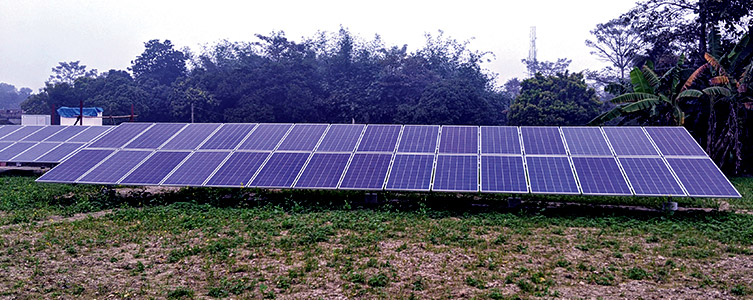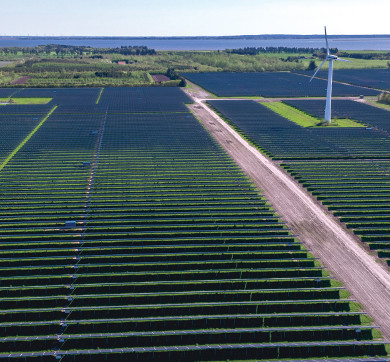June 2020 | 1629 words | 6-minute read
On a visit to a village a few years ago, Praveer Sinha encountered a farmer who shared knowledge and insights that surprised the MD and CEO of Tata Power. “The farmer inquired about a ‘helicopter’ that would help dispense pesticides and nutrients over crops,” says Mr Sinha, adding, “I realised he was talking about the use of drones in agriculture; our farmers were thinking way ahead of the curve in an effort to improve productivity and build sustainable livelihoods.”
In November 2019, when Tata Power announced the setting up of Tata Power Renewable Microgrid Ltd, in collaboration with the Rockefeller Foundation, it was with the vision to empower countless such farmers as well as rural enterprises and homes through access to affordable, reliable electricity by scaling up an innovative microgrid model. The model, to be implemented by Tata Power in collaboration with Smart Power India (SPI) — an initiative of the Rockefeller Foundation — and the Institute for Transformative Technologies (ITT), is expected to impact 25 million rural lives over the next five years.
The problem of energy poverty
Energy poverty is one of modern India’s most pervasive problems, primarily impacting its rural areas. Businesses and households in villages continue to rely on alternative sources to power daily needs — with more than 40 percent of enterprises in states like Bihar and Uttar Pradesh relying on non-grid sources of power.

Where supply of grid power does exist, it is scattered and intermittent. “In the last two or three years, the government has, under the Saubhagya Scheme, electrified houses in rural areas,” says Mr Sinha. “It is available for 10 percent of houses in a village as well as for some public services like the panchayat and school; moreover, this supply is only available for an average of eight hours. In many cases, there is no power supply for three days, followed by electricity for 14 to 16 hours in a day.”
Understandably, erratic power supply has proven to be unconducive to running businesses. Commercial activities in the village like local shops, atta chakki (flour mill), oil expeller or RO (reverse osmosis) plant do not have continuous electricity supply, often getting power at odd hours of the night when no personnel are around to operate the machinery nor customers to avail their services. “If a rural entrepreneur knows he can run his atta chakki for six hours in the day, he can make a more steady income,” explains Mr Sinha. “Or, where mustard is grown abundantly, if an entrepreneur is able to power an oil expeller, he can make mustard oil and have a more sustainable livelihood.”
A large part of why rural India has poor electrical infrastructure is the inherent unattractiveness of operating in far-flung areas for DISCOMs (distribution companies) that bring power lines over long distances to supply to remote villages. These lines and the overall network are non-remunerative to maintain and service because supply in villages is heavily subsidised, making it an uncompetitive, commercially unviable business.
To counter this, most rural businesses and households resort to using non-grid sources such as DG (diesel generator) sets that are neither economical nor eco-friendly.
A case for microgrids
Microgrids have emerged as a cost-effective solution for rural electrification in developing markets like India. In rural areas that are physically cut off from regular grids, solar and renewable microgrids can replace costly options like diesel and have also proven to be a more clean, affordable source of energy than centralised grids — the installation of which can be prohibitively expensive and drawn out.
Solar microgrids can range from 1kW to several megawatts. A 4kW grid can power a village of 100 homes and generate electricity worth 33,000 a year.
“Our purpose has always been to empower rural people and businesses by creating a development model wherein they can carry out economic activities and thereby improve their quality of life,” says Mr Sinha. “The solution has to be power that is low-cost enough to be viable for a household to afford, while also being able to compete with DISCOMs that receive government subsidies.” Economics also dictates that there be a certain minimum consumption in rural areas, which cannot be fulfilled only by households that use less electricity. The need to encourage industrial and commercial users is pressing.
Through installation of solar panel microgrids, Tata Power has brought down cost by nearly 50 percent, with scope to further reduce cost by another 20 to 30 percent. “Once the capital cost is reduced, your cost of financing and other operations will also reduce, and the price rural customers have to pay for electricity will decrease as well,” says Mr Sinha.
Bringing reasonably priced electricity to villages has opened up a slew of opportunities for rural entrepreneurs and has the potential to transform lives. Mr Sinha elaborates, “Milk co-operatives can have access to electric chiller plants for storing collected milk to be transported to cities or milk processing centres nearby. A couple of farmers equipped with an electrified pump set are able to distribute water to other farmers in a 5km radius. An RO plant run on electricity can supply water to nearby villages as well, at a nominal cost of 1 per litre. E-rickshaws charged with cheap electricity can bring cleaner transport options to rural areas, while earning a livelihood for the rickshaw owners. Every village can have a digital classroom powered by affordable electricity. Farmers can use drones and other technology to improve productivity. Through access to the internet, they can get the best price for their crops by researching market prices and the best places to sell their produce.”
The effort has also enabled another unique livelihood for some. The company has trained locals and employed them as gram vidhyut pratinidhis (village energy representatives), who not only maintain the system but also facilitate the billing and collection of dues.
The new livelihood avenues, made possible by the microgrids, highlight the factors that have made this project scalable. Most distributors believe that the poor are unwilling to pay, and thus consider decentralising renewable energy for rural areas a bad investment. Smart Power India has, however, noted that when energy providers offer a high-quality service responsive to customer needs, users will pay, regardless of their socio-economic status; more so, when continuous power supply ensures they can increase their incomes.
It takes a village
The microgrid project has been made possible through a series of valuable partnerships. The project’s genesis started over five years ago when Tata Power brought in students from the Massachusetts Institute of Technology to identify electrified or partially electrified villages, using satellite imagery. Following data analysis of over 40,000 satellite images, they came up with an electrification plan based on the number of houses per village.
This was followed by microgrid technology intervention, most notably from ITT’s ‘utility-in-a-box’, an innovation that protects sensitive equipment from India’s harsh summer heat and torrential monsoons. The mini-grid solution is neatly compressed into a little box that can be stored below solar panels, thus saving valuable square footage. It also reduces build-time from months to a matter of weeks, with a significant cost reduction that makes it more commercially viable.
Through its work with ITT, Tata Power started conversations with The Rockefeller Foundation, which was supporting a pilot project of the institute. “We realised there was a common purpose,” says Mr Sinha. “The Foundation has always supported socio-economic programmes in countries that face challenges in the areas of education, electricity, development and healthcare. The Tata group has similar values and goals, and that’s why the Foundation makes for the perfect partner.”
“We have an unprecedented opportunity to transform the lives of millions of people in India by providing access to power,” says Dr Rajiv J Shah, president, The Rockefeller Foundation. “Providing reliable electricity to the communities that need it most is one of the best ways for us to end poverty and unleash economic opportunity in our lifetimes.”
While the Tata Trusts provided the initial financial support, The Rockefeller Foundation and SPI later stepped in to arrange finance at a very low cost — both debt and equity — so that the business becomes commercially viable. “If the business continues on a grant basis and does not become commercially viable, we would not be able to scale it up,” says Mr Sinha. “On a grant basis, you could electrify about a 100 villages, nowhere close to the 10,000 villages we are aiming for.”
TP Renewable Microgrid Ltd anticipates setting up 10,000 microgrids through 2026, thus:
- Supplying clean power to 5 million households
- Directly impacting 25 million lives
- Reducing carbon emissions by 1 million tonnes a year
- Reducing burning of diesel by 57 million litres a year
- Electrifying 100,000 rural enterprises
- Generating 10,000 new green jobs
- Providing irrigation for 400,000 farmers
Making a start
TP Renewable Microgrid Ltd has begun installations in four districts — two in Uttar Pradesh and two in Bihar — and the focus going forward will be on some of the 115 backward districts identified by the Government of India. Mr Sinha says, “We are looking at states where access to electricity supply is poor such as Bihar, Uttar Pradesh, Madhya Pradesh and Rajasthan, as well as pockets of Assam and Orissa.”
The company has identified 100,000 villages in India with 400+ households each, which is the minimum size of a village through which maximum impact can be ensured, to achieve the 25 million milestone.
TP Renewable Microgrid Ltd represents an important scaling up of efforts to provide access to affordable, reliable and clean electricity in India; and perhaps its greatest achievement, as the world’s largest microgrid developer and operator, will be serving as a model for expanding access to more than 800 million people who are without power worldwide.
—Anuradha Anupkumar








